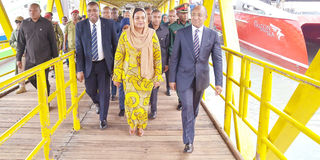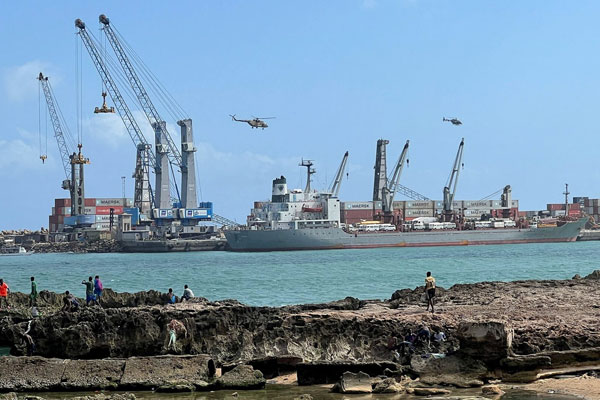Bakhresa’s hard and long journey in building Azam Marine

Zanzibar's President Hussein Mwinyi, his wife Mariam and the second Vice President Hemed Suleiman Abdulla leave the Malindi Port shortly after launching of Kilimanjaro 8
Dar es Salaam. Azam could probably be the most successful marine transport company in Tanzania but to reach that far, it has gone through ups and downs which, at some point, threatened to tear the firm apart.
The operating environment was so tough during the early days of the Azam Marine’s life that on several occasions, the company had to sell its ships as scrap metals and went home with losses, its managing director, Abubakar Aziz Salim, said yesterday.
Briefing the Zanzibar President, Dr Hussein Mwinyi during the ceremonial launching of the Azam Marine’s new ship named ‘Kilimanjaro 8, The Falcon of the Sea’, Mr Salim, said between 1990s and early 2000, the company sold at least five ships as scrap metals.
“The marine transport sector has a number of challenges that have seen some players collapsing. As for us we started by bringing into the country our Kilimanjaro 1 ship and another one named ‘Kondo’ but unfortunately the existing environment could not allow us to operate as expected and so the company was forced to sell them as scrap metals,” he said.
Though he did not reveal the actual operating environment that adversely affected the company’s operations in the 1990s, that was also precisely the time when Tanzania was gradually liberalizing its economy by increasingly adopting private sector players.
Mr Salim said after some time, the company brought three more ships with business names of Sea Bus 1, 2 and 3. But despite being brought as new ships, they failed to operate and ended up being sold as scrap metal.
“So it was due to continuous innovation and investment that the company has managed to remain in the market to-date,” he said, detailing how in 2010, it (the company) decided to come up with a new business strategy in its effort to start operating profitably and overcome past challenges.
Since then, Azam Marine has invested $120 million with which it brought into the country a total of 13 ships since then.
“All the profit that we got throughout the period was re-invested,” he said.
The company – which now transports two million people, including 180,000 foreign nationals annually between Dar es Salaam and Unguja - has also received loans from a number of domestic and foreign financiers to the tune of $50 million.
At the same time, the company – which directly employs 400 people - has sold its Kilimanjaro 1, 2 and 3 to Mexico and Seychelles where they were still being used for purposes of tourism and transporting of passengers.
The money obtained through the sale was spent on buying the new ship, the Kilimanjaro 8.
Considering that the ships travel in the sea, Mr Salim said, their lifespan is that of between four to five years and after that, operation costs rise significantly. “The costs include regular repairs, purchasing of spare parts and bringing expatriates who come to work on their repairs,” he said, requesting the government to consider reducing some taxes.
“These ships do not make a meaningful business to us as investors. However, they are a key door to Zanzibar’s economy and tourism,” he said. Azam Marine needs 750,000 liters of diesel per month to operate, Mr Salim said, requesting the government to consider reducing the taxes and levies on diesel. The other challenge is that of a lack of space at Malindi Port to effectively accommodate all the passengers.
In response, President Mwinyi commended the role of the private sector in improving travelling between Dar es Salaam and Unguja and to Pemba.
He said the government was aware of a lack of space at the Malindi port which results into congestion of passengers. This, he said, was why it was looking up to a long term solution to the challenge by implementing a new and modern ferry terminal project at Maruhubi area.
Dr Mwinyi asked Azam Marine help the government in the provision of modern transport equipment between Unguja and Pemba.
“Residents of Pemba would also want to spend the shortest possible time in travelling between Unguja and Pemba and if possible, Tanga…,” he said.
The Kilimanjaro 8 has been built for a period of 18 months in Hobart, Australia.
It is a modern ship that has the capacity of carrying 631 passengers. It has three classes as economy which has the capacity of 559 passengers; 56 in the VIP and 16 in the Royal Class.
It runs on two engines of a total of 8,000 horsepower. The ship was named Falcon because it was built to look like a falcon bird. The shape helps the ship to effectively sail through the water by easily dividing the sea waves and defeat any resistance by wind.




